People and Personalities of Darrang District
People and Personalities of Darrang District
The big stories often make the headlines of our historical narratives, but history is not only about the landmark events - it finds shape and character in the myriad events that led up to a flashpoint of change. An attempt to discover and document stories of people, events, and places linked to the freedom struggle of India at the micro level of the district has led to the creation of a Digital District Repository. Stories in this section can be broadly classified under - People & Personalities of Darrang district.
Chathu Ram Das
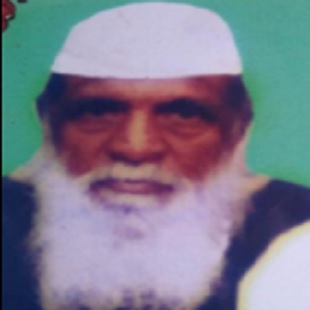 Chathu Ram Das was born in October 1923 in the village of Kacharijhar District of Darrang, Assam. His parents, Khobhariram Das and Motiswari Das, instilled in him a sense of patriotism from an early age. Despite facing obstacles, he pursued his education until Class VIII.
Chathu Ram Das was born in October 1923 in the village of Kacharijhar District of Darrang, Assam. His parents, Khobhariram Das and Motiswari Das, instilled in him a sense of patriotism from an early age. Despite facing obstacles, he pursued his education until Class VIII.
During the 'Quit India Movement' led by Mahatma Gandhi to free India from British rule, he participated in the movement and delivered messages to scattered Congress volunteers in various locations in Darrang, like Kalaigaon, Dumunichowki, Duni, Tangla and sometimes even Guwahati.
After India gained independence, Chathu Ram Das returned home and completed his education up to Class VIII as a private candidate. To support his poor family, he worked as an L.P. Teacher from 1951 to 1953. Later, he became a contractor for the construction of the Brahmaputra embankment from Rangamati to Kuruwa, which provided a steady livelihood for his family.
In recognition of his immense contribution to the freedom struggle, the Government of Assam awarded him the freedom fighter pension on 30 May 2006. Chathu Ram Das also played a significant role in education, establishing the Lal Bahadur Sastri L.P. School in his village, Kacharijhar. On October 1976, he participated in an event where the statue of Mahatma Gandhi was unveiled in front of the Janata Bhawan wing, following an invitation from the Assam Government.
Chathu Ram Das passed away on 2 July 2009.
Dineswar Sarma
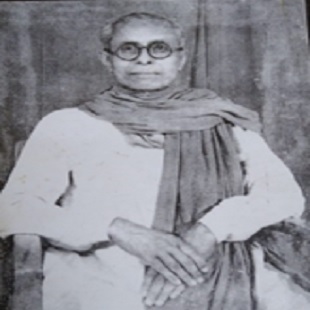 Dineswar Sarma was born on 9 July 1894, in Byaspara village under Lokrai Mauza of Darrang district, Assam. His father’s name was Dehiram Sarma and his mother was Rupeswari Devi. He was popularly known in the district as Pandit Dineswar Sarma since he started his career as a school teacher.
Dineswar Sarma was born on 9 July 1894, in Byaspara village under Lokrai Mauza of Darrang district, Assam. His father’s name was Dehiram Sarma and his mother was Rupeswari Devi. He was popularly known in the district as Pandit Dineswar Sarma since he started his career as a school teacher.
At its annual conference in Tezpur in December 1920, the Assam Association resolved to support the Non-cooperation programme announced by the Indian National Congress assembly in Nagpur. He attended the historic Assam Association meeting held at Tezpur on behalf of the Mangaldai sub-division. The Assam Association thereafter merged in 1921 with the newly established Assam Provincial Congress Committee. He actively led the Boycott movement after Gandhi's visit to Assam in 1921. In addition to being the first patriot to resign from his position as a teacher in 1920,Dineswar Sarma spent 105 days in Jorhat Jail for participating in the freedom movement in 1921. His property had also been seized by the British Government because of anti British activities. The then-governing body established a police outpost at his parent's home as a form of punishment for him. Additionally, in 1930–1931, he received a six-month sentence. He was also known for his fight against untouchability, and in 1946, he played a vital role in uniting the indigenous people against the infiltrators who took out large processions demanding Pakistan in and around Mangaldai town.
On August 15, 1972, the Prime minister, presented him with the Tamrapatra Citation in recognition of his exceptional national service. Dineswar Sarma breathed his last on August 26, 1975.
Jitendra Nath Sarmah
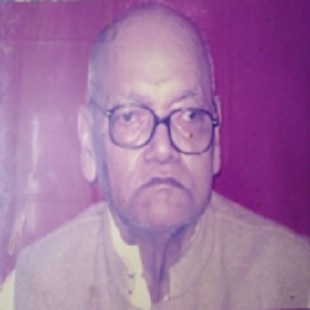 Jitendra Nath Sarmah was born on 13 May 1925 in the village of Barigaon under the Mangaldai sub-division of Darrang district, Assam. His father’s name was Joydev Sarmah and his mother’s name was Rukmini Devi.
Jitendra Nath Sarmah was born on 13 May 1925 in the village of Barigaon under the Mangaldai sub-division of Darrang district, Assam. His father’s name was Joydev Sarmah and his mother’s name was Rukmini Devi.
During the Quit India movement in 1942, he actively engaged in the freedom movement, resulting in the issuance of a non-bailable warrant against him. The Officer-in-Charge of Mangaldai Sadar Thana sought to apprehend him. However, he skillfully evaded capture by crossing the Bhomoraguri bridge via boat, making his way to Mariani in the Jorhat district of Assam. There, he went underground for a period of 18 months.
Amidst the Second World War, he joined the Indian National Army (Azad Hind Fauj) as a dedicated volunteer and received training in Nagaland under the leadership of Netaji Subhas Chandra Bose. A camp was established on the banks of the Bhogdoi river in Assam, led by Lieutenant Colonel N. Nagalingam and Captain Umesh Chandra Dev Choudhury, to train INA members. He returned to the Darrang district alongside N. Nagalingam and Captain Umesh Chandra Dev Choudhury in 1944-1945. In the Darrang district, he initiated a movement by setting up three camps: Borbori, Tokankata, and Mudoibori. He actively participated in the revolution against the proposal to merge Greater Assam with East Pakistan, put forth by the Cabinet Mission.
After Independence, Jitendra Nath left active politics and proceeded to his village. He was the founder of modern Deomornoi. Most of the Institutions were established due to his personal efforts. He was awarded a Tamrapatra by the Government of Assam in 1997. He had also received a State pension for Freedom Fighters.
Jitendra Nath breathed his last on May 4, 2010.
Khiteswar Nath Barua
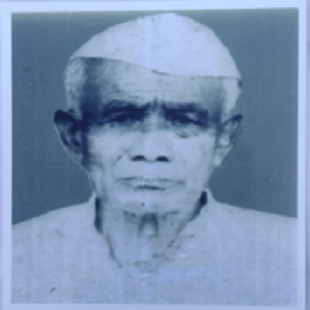 Khiteswar Nath Barua was born in the village of Gopalpur in the Darrang district of Assam in 1905. His father, Ani Nath and mother, Premada Nath raised him there. Khiteswar Nath Barua received his primary education at Patgirichuba LP School in Gopalpur. After completing his primary education, he attended Dumuni chowki MV School for further studies. However, he left the school midway and decided to join the Indian freedom movement.
Khiteswar Nath Barua was born in the village of Gopalpur in the Darrang district of Assam in 1905. His father, Ani Nath and mother, Premada Nath raised him there. Khiteswar Nath Barua received his primary education at Patgirichuba LP School in Gopalpur. After completing his primary education, he attended Dumuni chowki MV School for further studies. However, he left the school midway and decided to join the Indian freedom movement.
In 1930, he became a member of the Indian National Congress. He actively participated in the Mangaldoi District Congress Committee from that day onwards. In 1931, he and a few colleagues were arrested by the British Police for their revolt against the British Government. He was sent to Mangaldoi jail for 18 days initially and then to Tezpur jail for one year. After his release, he resumed his activities, which led to his imprisonment once again, this time for six months.
In 1934, he had the privilege of meeting Mahatma Gandhi when the latter visited Assam. During Gandhi's three-day stay at Sarania Ashram in Guwahati, Khiteswar Nath Barua had the opportunity to spend time with him. Additionally, when the renowned freedom fighter Vinoba Bhave visited Darrang District for his "Gram Daan-Bhudaan Work," Barua accompanied him for a month. Vinoba Bhave also visited Khiteswar Nath Barua's home in Gopalpur.
During the Quit India movement in 1942, he was placed under house arrest. However, he did not abstain from participating in the movement. He was appointed as the captain of a revolt camp.
On 15 August 1972, when India completed 25 years of freedom, the Government recognized Khiteswar Nath Barua as a "Swadhinata Sangrami" (Freedom Fighter) and "Mukti Yodha" (Liberation Warrior). As a token of recognition, he was presented with a copper plate by the then Prime Minister of India, Indira Gandhi, in Mangaldoi in 1972. In 1997, he received another Copper Plate from the Chief Minister of Assam, Prafulla Kumar Mahanta, for his contributions to the freedom movement.
Khiteswar Nath Barua was also a close friend of the former President of India, Fakhruddin Ali Ahmed. This unsung hero of the Indian freedom movement passed away at his residence on 30 November 2002 at the age of 97.
Kanaklata Barua
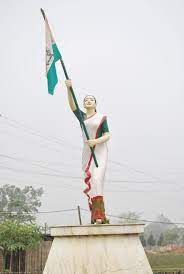 Kanaklata Barua was a young freedom fighter and martyr who sacrificed her life for the freedom of India. She was born on 22nd December, 1926 at Barangbari in the Darrang district of modern Assam.
Kanaklata Barua was a young freedom fighter and martyr who sacrificed her life for the freedom of India. She was born on 22nd December, 1926 at Barangbari in the Darrang district of modern Assam.
During the Quit India movement, Kanaklata, along with a few youngsters of “Mrityu Bahini”, a youth association, marched towards the Gohpur Thana on 20th September, 1942 to hoist the tricolour flag in the compound. The officer in charge of the police station stopped the procession. Kanaklata, who was holding the tri-colour flag, repeatedly requested the policemen to at least let the womenfolk continue but they denied and threatened to shoot. But such threats could not break the spirit of the activists and Kanaklata fearlessly continued the procession holding the tri-colour flag. While she was proceeding into the police station, the police shot Kanaklata and she died on the spot.
Kanaklata Barua, who resisted the British till her last breath, was martyred for the freedom of India at the young age of 16.
Golok Kakati
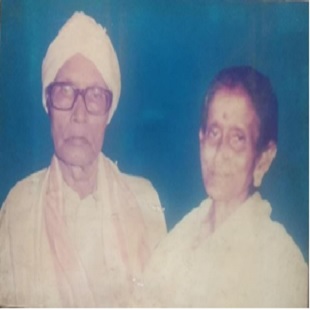 Golok Kakati was born in Pasigaon of Jamugurihat of Sonitpur district of Assam on 25 May 1922. The name of his father was Puwaram Kakati and his mother was Faguni Kakati. The name of his wife was Kunjalata Kakati. He had two sons and three daughters. After passing matriculation he went to Jorhat and took Narmal training at Jorhat Narmal Training School. After that, he went to Dhaka to study Engineering, but for some communal offense, he had to return home before taking the degree. He joined congress when he was in class VII. He was a teacher. A meeting was held in 1937 at Berseria, where he led the procession of that meeting. Till 1942 he was a teacher cum congress volunteer. But once, while giving a lecture at a teacher’s meeting he was caught by the British officials and suspended from his job. After that, he got a permanent job at Tezpur Academy but he refused to work under the British government. For joining and leading the Quit India movement in Jamugurihat he was imprisoned in 1942. His associates were Purna Narayan Singha of Tezpur, Moina Neog, etc. On 14 August 1947, he became secretary of the Panchayat Congress. In 1978 he became an MLA from Sootia constituency. On 24 August 2001 at the age of 88, he passed away.
Golok Kakati was born in Pasigaon of Jamugurihat of Sonitpur district of Assam on 25 May 1922. The name of his father was Puwaram Kakati and his mother was Faguni Kakati. The name of his wife was Kunjalata Kakati. He had two sons and three daughters. After passing matriculation he went to Jorhat and took Narmal training at Jorhat Narmal Training School. After that, he went to Dhaka to study Engineering, but for some communal offense, he had to return home before taking the degree. He joined congress when he was in class VII. He was a teacher. A meeting was held in 1937 at Berseria, where he led the procession of that meeting. Till 1942 he was a teacher cum congress volunteer. But once, while giving a lecture at a teacher’s meeting he was caught by the British officials and suspended from his job. After that, he got a permanent job at Tezpur Academy but he refused to work under the British government. For joining and leading the Quit India movement in Jamugurihat he was imprisoned in 1942. His associates were Purna Narayan Singha of Tezpur, Moina Neog, etc. On 14 August 1947, he became secretary of the Panchayat Congress. In 1978 he became an MLA from Sootia constituency. On 24 August 2001 at the age of 88, he passed away.
Satya Nath Barua
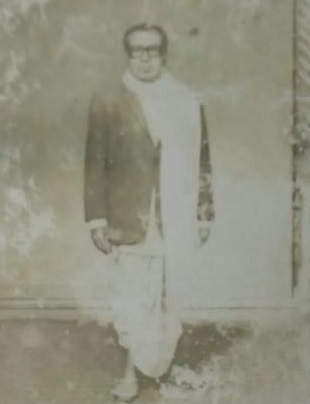 Satya Nath Barua was born in Niz Sarabari village of Darrang District of Assam on 24 October 1920. He passed M.V. from Patharughat M.V. School. Name of his father was Sabha Ram Barua and his mother was Guneswari Barua. He had two wives Premada Barua and Brinda Barua. He was a teacher and a congress worker.
Satya Nath Barua was born in Niz Sarabari village of Darrang District of Assam on 24 October 1920. He passed M.V. from Patharughat M.V. School. Name of his father was Sabha Ram Barua and his mother was Guneswari Barua. He had two wives Premada Barua and Brinda Barua. He was a teacher and a congress worker.
Satyanath Barua had a strong faith in Gandhism since childhood. He was a staunch devotee of truth and non-violence and believed in the expansion of Gandhi’s coherent principle among the masses. In 1940 he joined the congress Sewa Dal at the congress session of Golaghat. He was actively involved in the program of congress like Satyagraha, hunger strikes, meetings, picketing, hartal, etc.
Consequently, he was imprisoned for a period of three months along with a fine of Rs. 75. Because of the failure to pay Rs. 75, he was again supposed to jail for a period of 3 months.
The British imposed rigorous imprisonment for a period of 18 months along with his 12 associates for their participation in the Quit India Movement. At the district Jail, Tezpur, he met Fakharuddin Ali Ahmed, Omio Kumar Das, Siddhi Nath Sharma, Mohikanta Das, etc. from whom he got some valuable knowledge. His associates were Tangkeswar Sharma, Ratneswar Sharma, Kumud Chandra Sharma, Bipin Chandra Medhi, Jio Ram Deka, Pani Ram Das, Champa Barua, Kumud Chandra Sharma of Panara, Ajan Kakati, etc. He was entrusted with the duty as an associate while hoisting the National Flag on 15 August 1947 at Mangaldoi from Sewa Dal.
He met Jawaharlal Nehru, Sardar Ballav Bhai Patel, Gopinath Bordoloi, and Mahatma Gandhi as a Prominent leader of Sewa Dal of Mangaldoi Subdivision of Darrang District. He had also given shelter to Santa Binowa Bhabe at Sankara Mission for 24 hours. In his locality, he was directly associated with some social work like founding different institutions like L. P. School, High School, Namghar, etc. He was also a founder member of Namkhala State Dispensary and Burhinagar College. Apart from that, he was associated with all social activities in his area.
In Gomthapara, on 19 March 2008 at the age of 89, he passed away.
Pani Ram Das
Born in the small town of Mangaldoi in Darrang district in Assam, Pani Ram Das is considered the first recognised journalist from this district. He wrote for prominent newspapers like The Assam Tribune, Assam Sevak, etc. Born to a peasant family, his original title, ‘Saikia’ was changed to ‘Das’ by his father, with the hope that he would become a ‘servant of the people.’
A bright student, Das performed well throughout school and secured a first division in the Matriculation examinations conducted by Calcutta University. However, unlike his classmates, instead of pursuing a lucrative job, Das decided to join the freedom struggle. It is believed that even as a student, Das boycotted the Coronation of King George VI, for which he was rusticated by the school authorities. Pani Ram Das was deeply inspired by the principles of Mahatma Gandhi and was mentored by a prominent Congress leader, Hem Chandra Barua. Das was first imprisoned in 1941 by the British government. In December 1942, he along with other associates, set the Mangaldoi Revenue Circle Office ablaze, which led to a shoot at sight order being taken out on him by the British government. He was arrested in 1943 and spent two years in jail.
Even after independence, Pani Ram Das, the dedicated social worker, remained committed to the people and worked for their welfare. He founded the Kalaigaon Sevashram. Pani Ram Das passed away on 30 November 2010.
Malati Mem
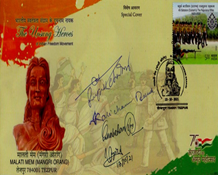
Also known as Mungri, Malati Mem was an Assamese tribal freedom fighter who took part in the anti-opium campaigns in tea plantations. During the Swadeshi movement, when Congress members were boycotting foreign liquors and opium, Malati Mem was one of the bold labourers who joined in the fight. She was eventually killed in an encounter in 1921, but is remembered as the first female martyr of Assam.
Source :
- Indian Culture Portal
- Prafulla Keot, Contributor for CCRT
- Mrinal Kumar Nath, Contributor for CCRT
- Jyotsna Kakati, Age: 60, Village: Ranga Pukhuri Par, Mission Chariali, Tezpur
- Name: Heramba Prashad Barua, Age : 59, Village: Gomthapara
- Special Cover issued by Department of Posts on 13th October, 2021
- Azadi Ka Amrit Mahotsav
Last Modified : 8/14/2023
